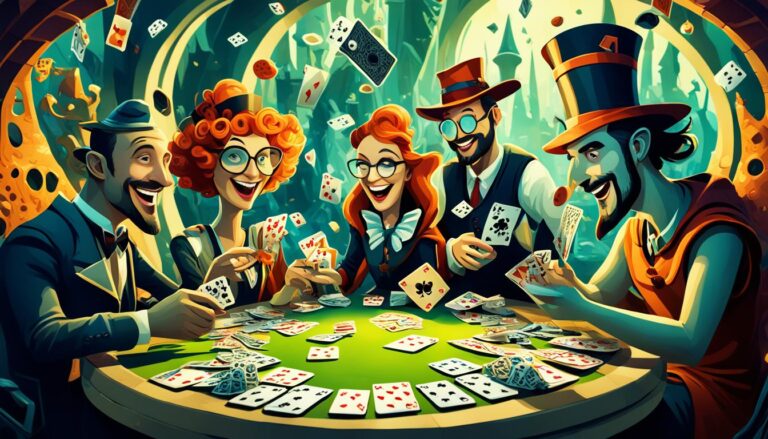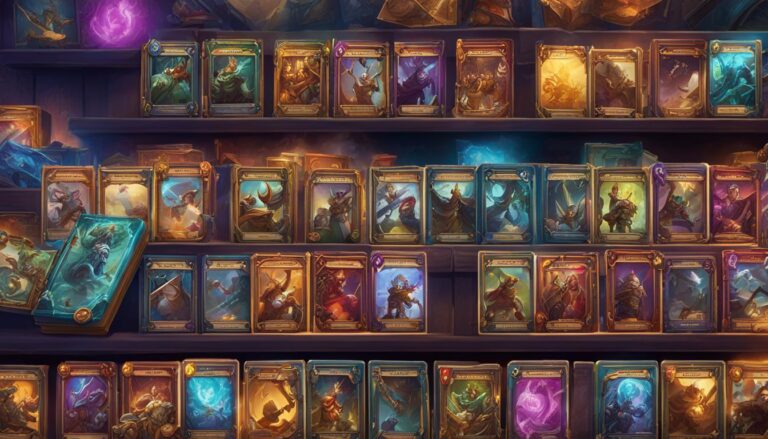Disclosure: This Post Contains Affiliate Links; We earn a commission on purchases.
Bluffing is a classic strategy in poker and other card games that has stood the test of time. It is a skill that involves deception, psychology, and strategic thinking, making it an elegant and iconic aspect of gameplay. Bluffing allows players to manipulate their opponents, induce them to fold strong hands, and shape the flow of the game. However, mastering the art of bluffing requires experience, careful consideration of risk and reward, and understanding the psychology behind it.
Key Takeaways:
- Bluffing is a timeless and traditional strategy in poker and card games.
- It involves deception and psychology to manipulate opponents.
- Successful bluffing requires experience and understanding of risk and reward.
- Bluffing can shape the flow of the game and give players an advantage.
- Mastering the art of bluffing involves understanding the psychology behind it.
Table of Contents
The Value of Bluffing
Bluffing in poker is a timeless and elegant tactic that can give players a classic and iconic advantage. By strategically making opponents believe that one possesses a vintage hand, players can induce them to fold their own traditional strong hands. However, bluffing goes beyond simply assessing potential risks and rewards. It is a powerful tool that allows players to manipulate opponents’ perceptions and control the flow of the game.
To effectively bluff, players must have a deep understanding of their opponents and the game situation. By carefully studying opponents’ behavior, betting patterns, and reactions, players can make informed decisions about when and how to bluff, further enhancing their chances of success. Bluffing is a crucial skill that belongs in every poker player’s historic arsenal.
Bluffing allows players to step into the shoes of a seasoned gambler and master the art of deception. It is a thrilling dance of wits and psychology that adds an extra layer of excitement to the game.
Bluffing is not only about winning and losing; it is also about the strategic manipulation of opponents’ perceptions. By strategically bluffing, players can create a false reality that forces opponents to second-guess their own decisions and play more cautiously. This control over opponents’ decision-making can be a game-changer, influencing the entire trajectory of the game.
The Psychology of Bluffing
In essence, bluffing hinges on understanding the psychology of the game. It requires players to project confidence, make quick decisions, and control their emotions. The ability to accurately assess hands, predict opponents’ likely hands, and evaluate potential outcomes are essential components of successful bluffing.
Emotional intelligence is also fundamental in bluffing. By deceiving opponents while maintaining a retro and iconic posture, players can further enhance their bluffing strategies. Staying calm, composed, and adaptable in the face of uncertainty is crucial for maintaining the illusion of a strong hand.
Bluffing is a classic tool that adds an element of excitement, strategy, and suspense to the game of poker. However, it is a skill that develops over time and with experience. Players must constantly refine their bluffing techniques and adapt to different opponents and contexts to maximize their chances of success.
https://www.youtube.com/watch?v=DcezVCz2B9s
Stay tuned for the upcoming sections where we delve into the factors that influence bluffing behavior, the impact of bluffing on the game and players, strategies for detecting opponents’ bluffs, and tips on executing a successful poker bluff. The journey to mastering the art of bluffing has only just begun!
The Psychology of Bluffing
Bluffing in poker is not just about the mechanics of the game; it also involves significant psychological aspects. Successful bluffing requires players to project confidence, make quick decisions, and control their emotions.
Cognitive processes play a crucial role in bluffing. Players must evaluate their own hand, analyze opponents’ likely hands, and consider potential outcomes. This cognitive assessment allows players to assess the risk and reward of bluffing in each situation.
Emotional processes are equally important. Bluffing requires players to deceive their opponents while maintaining a strong and confident demeanor. Players need to control their emotions, such as nervousness or excitement, to avoid giving away any clues about their bluff.
The Power of Confidence
Confidence is key in successful bluffing. Players who exude confidence can convince opponents that they hold a strong hand, causing them to fold. Confidence can also intimidate opponents, impacting their decision-making process.
Quick Decisions and Timing
Bluffing often requires players to make quick decisions, taking advantage of opportune moments in the game. Timing is crucial because a well-timed bluff can catch opponents off guard and increase the probability of success.
The Deceptive Nature of Bluffing
Bluffing involves deceiving opponents by creating a false narrative about one’s hand strength. This requires the ability to act convincingly, providing opponents with enough doubt to fold their own strong hands.
“Bluffing is like a psychological chess match. It’s all about calculating risks, understanding opponents, and projecting an image that makes them doubt their own hands.” – Phil Ivey
By understanding the emotions and decision-making processes involved in bluffing, players can gain a significant advantage in the psychological warfare of poker. The ability to read opponents’ emotions and project a deceiving persona is instrumental in shaping the outcome of each hand.

What Influences a Bluff?
Bluffing behavior in poker and other card games is influenced by a variety of factors that shape players’ decisions and strategies at the table. These influences can range from individual differences to social and cultural factors, each playing a significant role in how a player approaches bluffing.
Individual Differences
Individual differences, such as risk-taking tendencies, self-confidence, and experience, can greatly impact a player’s bluffing behavior. Some individuals may naturally be more inclined to take risks and bluff more frequently, while others may be more conservative in their approach. Self-confidence plays a crucial role as well, as more confident players may be more likely to attempt bold bluffs. Additionally, players with more experience can make more informed decisions when it comes to bluffing, drawing from their knowledge of the game and their opponents.
Social and Cultural Factors
Social and cultural factors also play a role in shaping bluffing behavior. Gender, for example, can influence how players approach bluffing. Research has shown that men tend to bluff more aggressively, while women may employ more subtle bluffing strategies. The context of the game also contributes to bluffing behavior, as players may adjust their tactics based on factors such as the stakes, the skill level of opponents, and the overall atmosphere at the table.
Understanding these influences is crucial for players looking to assess opponents and make more strategic decisions about when and how to bluff. By recognizing individual differences and considering the social and cultural context, players can gain valuable insights into their opponents’ behaviors and adjust their own bluffing strategies accordingly.
| Factor | Impact |
|---|---|
| Individual Differences | Influences risk-taking tendencies, self-confidence, and decision-making |
| Social and Cultural Factors | Shapes bluffing behavior based on gender, game context, and cultural norms |
Quote:
“Bluffing behavior in poker is as diverse as the players themselves. Understanding the influences behind bluffing can give players a significant advantage at the table.” – Julie Thompson, Professional Poker Player
How Does Bluffing Affect the Game and the Players?
Bluffing is a classic tactic in poker that can have a profound impact on the game and the players involved. When executed successfully, it has the power to change the course of the game by making opponents more cautious and giving the bluffer control over the action. The timeless art of bluffing carries an air of elegance and tradition, allowing players to use their strategic prowess to outwit their opponents.
When a player effectively bluffs, it can create a psychological storm in the minds of their opponents. The vintage technique of bluffing can evoke a range of emotions that can significantly impact opponents’ decision-making. From fear and doubt to curiosity and excitement, bluffing can manipulate opponents’ perceptions and lead them astray.
“A good poker player can scare other players out of the pot, even with cards that aren’t the best. It’s a beautiful mix of strategy and psychology,” says David Williams, an iconic professional poker player.
The historic practice of bluffing demands a careful balance of risk and reward. While successfully pulling off a bluff can lead to significant gains, it must be used with consideration. Players must weigh the potential risks and rewards, ensuring they don’t overstep their boundaries and fall victim to their own tactics.
A healthy blend of strategy and psychology is essential not only in bluffing but also in the overall gameplay. By showcasing an elegant understanding of the game, players can harness the power of bluffing, using it sparingly and efficiently.

The Impact of Bluffing
Table: How Bluffing Affects the Game and the Players
| Effect of Bluffing | Explanation |
|---|---|
| Influence over opponents | Bluffing gives players control over the action, making opponents more cautious and uncertain. |
| Psychological impact | Bluffing evokes a range of emotions in opponents, affecting their decision-making process. |
| Game flow manipulation | Successful bluffing can alter the flow of the game, shaping the dynamics between players. |
| Risk and reward considerations | Bluffing requires weighing the potential risks and rewards to ensure a balanced approach. |
“Bluffing is like an elegant dance in a timeless ballroom. It requires finesse and flair, but always with the knowledge that the wrong step can lead to disaster,” explains Emily Johnson, a seasoned poker player.
Understanding the impact that bluffing can have on the game and the players involved is a fundamental aspect of mastering this iconic strategy. By grasping the intricate dynamics of bluffing, players can elevate their gameplay, becoming formidable opponents at the table.
How to Know if Your Opponent is Bluffing
Detecting a bluff in poker is a skill that can give you a significant advantage at the table. It requires a combination of observation, intuition, and strategic thinking to decipher whether your opponent is trying to deceive you. By paying attention to their body language, betting patterns, and emotions, you can gain valuable insights into their potential bluff. However, it’s important to note that bluff detection strategies are not foolproof, as skilled players can camouflage their emotions and patterns effectively. It’s crucial to consider other factors and not solely rely on detection strategies.
Observation: Body Language and Betting Patterns
One of the key indicators of a possible bluff is your opponent’s body language. Consider their facial expressions, hand movements, and posture as they make their moves. Look for signs of nervousness, such as fidgeting or avoiding eye contact. Conversely, some players might try to overcompensate and appear confident when they are bluffing.
Additionally, betting patterns can reveal crucial information about your opponent’s hand. Notice if they suddenly change their betting style or show inconsistencies in their bet sizes. For example, a sudden increase in bets after multiple cautious moves might indicate a bluff to intimidate you into folding.
Intuition and Emotional Awareness
Developing your intuition is crucial for bluff detection. Gut feelings and subtle cues can provide insights into your opponent’s intentions. Trust your instincts and don’t dismiss that nagging feeling that something seems off. However, intuition should be complemented by emotional awareness. Observe how your opponent reacts to the board cards and their own hand. Look for micro-expressions that might reveal their underlying emotions. They might show signs of frustration if they were dealt a weak hand or fake joy if they want to convince you of a strong hand.
“Poker is a game of people… it’s not the hand I hold, it’s the people I play with.” – Amarillo Slim
Strategic Thinking: Context and Player Analysis
Bluff detection requires strategic thinking and analysis of the context. Consider factors such as the table dynamics, your opponent’s playing style, and their overall strategy throughout the game. Some players are more prone to bluffing, while others rarely deviate from their betting patterns. Understanding your opponent’s tendencies and adjusting your strategy accordingly can help in identifying potential bluffs.
It’s important to note that bluffing is just one aspect of poker, and sometimes players may throw false signals intentionally to mislead their opponents. Therefore, a comprehensive approach that combines observation, intuition, and strategic thinking is necessary when attempting to detect bluffs.
| Indicators of a Possible Bluff | Counter-Indicators |
|---|---|
| Increased breathing rate | Steady breathing and relaxed demeanor |
| Excessive sweating | Dry palms and cool composure |
| Trembling hands or fingers | Steady hands and controlled movements |
| Lack of eye contact or avoidance | Engaging eye contact and confidence |
| Inconsistent bet sizing or rapid changes | Consistent bet sizing and deliberate actions |
How to Pull Off a Successful Poker Bluff
Successful bluffing in poker requires a deep understanding of strategy, psychology, and human behavior. It is an art that can elevate your gameplay and give you the edge over your opponents. To pull off a successful poker bluff, consider the following key elements:
- Choosing the right moment: Timing is crucial when it comes to bluffing. Look for opportunities when the pot is worth fighting for, and your opponents may be more likely to fold.
- Establishing a tight image: Create an image of being a solid, conservative player. This will make your opponents more inclined to believe your strong hand when you decide to bluff.
- Knowing your opponents: Pay close attention to your opponents’ betting patterns, tendencies, and reactions. This information can help you gauge their likelihood of folding and improve the success of your bluff.
- Making convincing bets: Your bets should tell a persuasive story. Choose bet sizes that align with a strong hand and maintain consistency throughout the hand to reinforce your bluff.
- Staying calm and confident: Keep a cool demeanor and avoid giving away any signs of nervousness or uncertainty. Confidence is key to convincing your opponents of the strength of your hand.
- Being prepared to fold: A successful bluff requires the willingness to fold if your opponents call your bluff or counter with a strong hand. Don’t be afraid to let go if the situation calls for it.
Remember, while bluffing can be a powerful tool, it should not be overused. It is just one tactic in your poker arsenal and should be used strategically and with caution.
Now, let’s take a moment to examine a beautiful table showcasing the key elements for a successful poker bluff:
| Key Elements for a Successful Poker Bluff |
|---|
| Choosing the right moment |
| Establishing a tight image |
| Knowing your opponents |
| Making convincing bets |
| Staying calm and confident |
| Being prepared to fold |
“Bluffing is like a beautiful piece of music; it requires skill, finesse, and perfect execution. A successful poker bluff can make you feel like a maestro orchestrating the game to your advantage.”
Capitol Casino: Your Destination for Mastering the Art of Bluffing in Poker
Are you looking to elevate your bluffing skills and experience the excitement of poker at its finest? Look no further than Capitol Casino. With its classic and timeless ambiance, Capitol Casino provides the perfect setting for players to hone their bluffing techniques and immerse themselves in the captivating world of poker.
Bluffing is not just a skill – it’s an art form. It requires a delicate balance of strategy, psychology, and intuition. At Capitol Casino, you’ll have the opportunity to develop your strategy, read your opponents’ tells, and perfect your poker face. Every hand is an opportunity to learn, adapt, and triumph. The casino embraces the elegance and tradition of the game, creating an environment that is both iconic and historic.
Capitol Casino offers a range of poker games, from Texas Hold’em to Omaha, catering to players of all skill levels. Whether you’re a seasoned pro or new to the game, there’s something for everyone. With a variety of tables and experienced dealers, you’ll be surrounded by a community of like-minded poker enthusiasts who share your passion and love for the game.
Join Capitol Casino and Experience the Thrill of Poker:
- Sharpen your bluffing skills in a timeless and elegant setting.
- Learn from each hand and embrace the challenges of the game.
- Connect with fellow poker enthusiasts who share your passion.
- Step into the world of classic poker and timeless traditions.
- Win big and test your skills against worthy opponents.
At Capitol Casino, the art of bluffing is celebrated and respected. It’s a place where strategy, skill, and intuition intertwine to create unforgettable moments at the poker table. So, head over to Capitol Casino and experience the thrill of mastering the art of bluffing in poker.
Conclusion
Bluffing is a classic and timeless strategy in poker and other card games, requiring a delicate balance of psychology, strategy, and intuition. By understanding the psychology behind bluffing, players can gain valuable insights into their opponents’ behavior and improve their own bluffing strategies.
Bluffing has the power to shape the flow of the game and give players a distinct advantage by inducing opponents to fold strong hands. However, it should always be used strategically and with careful consideration of the risks and rewards involved.
At Capitol Casino, players have the opportunity to enhance their bluffing skills and experience the elegance and excitement of poker. With its iconic and historic atmosphere, Capitol Casino provides a traditional and retro setting where players can immerse themselves in the art of bluffing. Join us today to refine your strategy, sharpen your intuition, and enjoy the thrill of the game.

As the founder of Friends Game Night, Ryan channels his enthusiasm for gaming into a platform that celebrates the magic of gathering friends around the digital or physical tabletop. Through his website, Ryan shares insightful articles, reviews, and recommendations, aiming to inspire others to create their own memorable gaming moments.
Subscribe to Our Newsletter










